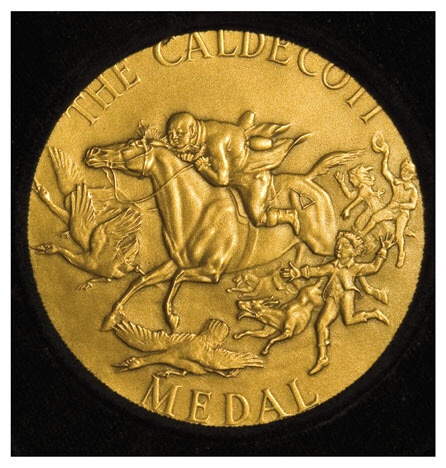Recently, I was asked for advice on putting together a basic mock Caldecott. The library staff member who reached out does not have a passion for picture books and was feeling pressured to put something together because other schools in her district participate. She had tried looking at the lists of other people’s mocks online and found herself overwhelmed by their length and was never clear on the intended age group. I’ve conducted elementary level mock Caldecott’s for years and was happy to help. Here is a slightly edited version of my advice to her.
First, think about why you want to conduct a mock Caldecott vote. There are lots of great reasons but peer pressure isn’t one of them. You may be giving up anywhere from a single class period to a month or more of instructional time if you are in the library setting and only seeing a given class once a week. Make sure your lessons are compatible with your learning objectives.
In my library I use a modified version of Megan Dowd Lambert’s Whole Book Approach to sharing picture books. If you are not familiar with her work, may I suggest her book Reading Picture Books with Children to you. She recommends teaching pre-readers to focus on artistic details in picture books such as such as end papers, font, trim size, color palate, the use of frames in art, and when illustrations cross the gutter to add meaning to a story beyond the text. With this in mind, a mock Caldecott for my young readers is in many ways the culmination of several months of talking about illustrations.
The next challenge is selecting books for your students to vote on. The selections must be geared at age 14 or under. The illustrator must be US born or a resident of the United States. The book must have been published in the previous year. That’s it. That could leave you with thousands of possible titles. So where do you get a list or pare it down?
I happen to love picture books and I read hundreds of them each year, most recommended by peers, students, and review sites. My lists are my own BUT that doesn’t have to be your cup of tea. There are many fabulous list makers out there. Colby Sharp and Mr Schu jointly created a list this year that can be accessed here.
A couple other wonderful blogs focusing Children’s Literature that create lists are posted on the School Library Journal website. My favorites are Travis Jonker’s ScopeNotes100 and Betsy Bird’s Fuse8. I am also fond of Horn Book’s Calling Caldecott blog.
That said, the published lists are super long and everybody has a different favorite. If you are overwhelmed, look for the overlap on other people’s lists. Also narrow them by the grade you are working with. Thinking K-1? Include books like Blue or The Rabbit Listened and avoid titles meant for older readers. Thinking grades 4-5? Consider books like The Stuff of Stars, Be Prepared, or What Would You Do With a Voice Like That. You want your students to learn to analyze how illustrations help tell a story at a level that will be meaningful to them.
Once you have your list, the next step is up to you. With kinders or first graders comparing two or three books with show of hands votes for several weeks with a winner selected the last week from all the prior week winners is perfectly acceptable. For older students you might break down elements of the selection process with points on Google forms and allow voting that way. If you need to go on beyond the actual week of the Caldecott announcements most little ones will be none the wiser. With older students it can be fun to watch the ALA live stream of the award presentations in class and celebrate together real time.
This year I spiced it up. My K-1 kiddos had 20 possible books laid out with a paper bag featuring the book cover next to each. They were each given 5 tickets and they voted on what books we will read in January by putting a ticket in that book’s bag. They could put all 5 tickets in one bag if they felt super strongly. They could put your tickets in 5 different bags. They could book talk favorite titles to friends. The class top 5 will be added with 3 librarian’s choice books to be the 8 books they may choose from on our final vote. Each of my classes will have a slightly different mix but I think that’s part of the fun. Our discussions of the books will focus on how illustrations add to the storytelling.
My 4th and 5th older students also learn the actual committee criteria, which are as follows:
Criteria for the Award
- The book must provide the child with a visual experience, one that unifies story elements, such as plot and theme, cohesively through the series of pictures.
- Children must be the target audience, with childhood being defined as up to fourteen years of age. Books within this entire age range may be considered, but the intended age group’s understandings, abilities, and appreciations should be taken into consideration.
- “Distinguished” is
-
- marked by eminence and distinction; noted for significant achievement
-
- marked by excellence in quality
-
- marked by conspicuous eminence
-
- individually distinct
- The work must be original; illustrations reprinted or coupled are ineligible
- The work must be published in the United States; original publications from other countries are ineligible
- The work must be published in the previous year
- The artist must be a United States citizen or have an established, maintained residence in the United States
- The artist’s entire body of work may not be taken into consideration.
from ALSC guidelines for the Caldecott Medal
I hope this post slightly demystifies the mock Caldecott process. Happy reading!

